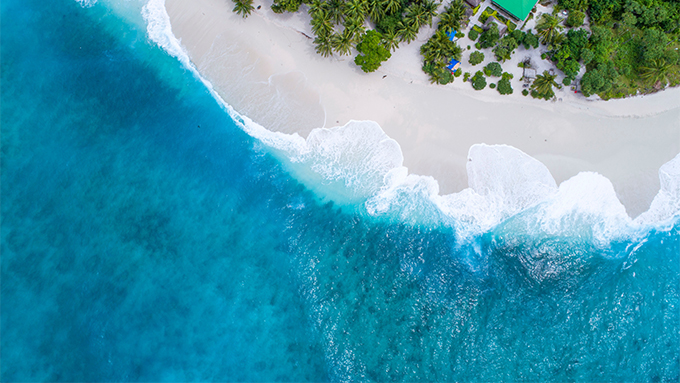Zero Waste Movement through Beach Sanitation, Ecobrick Greenhouse Development, and Marine Ecosystem Preservation in Efforts to Realize SDGs 2030

Downloads
Background:Banyuwangi Regency is one of the regions in Indonesia which is rich in beach tourism potential, one of which is Pulau Santen Beach which is located in Karangrejo Village, Banyuwangi District, Banyuwangi Regency. However, when the charm of this destination has decreased, the condition of the beach is dirty if left unchecked and no coastal vegetation is carried out, it can damage the marine biota in the vicinity. There is a need for a Santen Island community empowerment program that reviews conservation and sustainable use in order to meet the 14th Sustainable Development Goals (SDGs).
Objectives: Community Service entitled "Zero Waste Movement through Beach Environment Sanitation, Greenhouse Ecobrick Development, and Marine Ecosystem Preservation" aims to increase the knowledge, skills and economic independence of the Santen Island community regarding hiding santigi plants, MSME marketing strategies in tourist attractions, and waste management through making ecobricks.
Methods: The method used for the implementation of community service is through several stages including, the first stage in this community service program is the preparatory stage. This preparatory stage consists of three steps, namely an environmental survey, purchasing the right sources, and planning a community service program. The second stage of this community service program is the implementation stage and the third advanced stage of this community service program is evaluation.
Results: On the first day, there was an increase in the knowledge of the Santen Island community by 18.8%. On the second day there was an increase in public knowledge of 2.2%, and on the third day with ecobrick material there was an increase in public knowledge of 20.2%. This shows that the material can be well captured by the target of community service activities.
Conclusions:This activity is later expected to be a provision for the community to revive the tourism potential on Santen Island, namely edutourism which includes aspects of knowledge about cultivating santigi plants, healthy coastal environments through processing inorganic waste into goods of high economic value (ecobricks) and community economic independence through increasing financial capacitynew tourism products for edutourism on Santen Island.
Subiyanto, (2011) ‘Potensi Kekayaan Alam Kelautan Mendukung Kebijakan Kemdiknas dalam Pengembangan SMK pada Era Otonomi Daerah', Jurnal Pendidikan dan Kebudayaan, 17(5), pp. 576–587. doi:10.24832/jpnk.v17i5.50.
Adelina, H. et al. (2022) ‘Pengembangan Objek Wisata Bahari di Kecamatan Tirtajaya Kabupaten Karawang', Jurnal Kastara: Jurnal Pengabdian Masyarakat, 2(1), pp. 27–32.
Andriani, R. and Afidah, M. (2020) ‘Evaluasi Kegiatan Pengabdian kepada Masyarakat Dosen Universitas Lancang Kuning', Jupiis: Jurnal Pendidikan Ilmu-Ilmu Sosial, 12(1), p. 271. doi:10.24114/jupiis.v12i1.14680.
Asih, H.M. and Fitriani, S. (2018) ‘Penyusunan Standard Operating Procedure (SOP) Produksi Inovasi Ecobrick', Jurnal Ilmiah Teknik Industri, 17(2), p. 144. doi:10.23917/jiti.v17i2.6832.
Diah, A.A. and Syawie, M. (2015) ‘Pembangunan Kemandirian Desa Melalui Konsep Pemberdayaan: Suatu Kajian Dalam Perspektif Sosiologi the Development of Rural Resilience With Empowering Concept: a Study of Sociological Perspective', Sosio Informa, 1(2), pp. 175–188.
Fauzi, M. et al. (2020) ‘Pemberdayaan masyarakat melalui pelatihan pembuatan ecobrick sebagai upaya mengurangi sampah plastik di Kecamatan Bunga Raya', Riau Journal of Empowerment, 3(2), pp. 87–96. doi:10.31258/raje.3.2.87-96.
Guntur, K., Anik, S. and Ayuni, S. (2022) ‘Ecobrick sebagai Solusi Sampah Plastik di Desa Temuroso', 4(2), pp. 212–218.
Hazeri, G., Hartono, D. and Cahyadinata, I. (2016) ‘Studi Kesesuaian Pantai Laguna Desa Merpas Kecamatan Nasal Kabupaten Kaur Sebagai Daerah Pengembangan Pariwisata Dan Konservasi', Jurnal Enggano, 1(1), pp. 33–41. doi:10.31186/jenggano.1.1.33-41.
Istirokhatun, T. and Nugraha, W.D. (2019) ‘Pelatihan Pembuatan Ecobricks sebagai Pengelolaan Sampah Plastik di Rt 01 Rw 05, Kelurahan Kramas, Kecamatan Tembalang, Semarang', Jurnal Pasopati ‘Pengabdian Masyarakat dan Inovasi Pengembangan Teknologi', 1(2), pp. 85–90. Available at: https://ejournal2.undip.ac.id/index.php/pasopati/article/view/5549%0Ahttps://ejournal2.undip.ac.id/index.php/pasopati/article/download/5549/3111.
Lestari, M.M. (2013) ‘Potensi dan Tantangan Pengelolaan Sumberdaya Kelautan Dalam Penciptaan Masyarakat Pesisir Yang Siap Menjawab Perkembangan Zaman', Jurnal Selat, 1(1), pp. 8–12.
Mahendrayani, I.G.A.P.S. and Suryawan, I.B. (2018) ‘Strategi Pemasaran Daya Tarik Wisata Untuk Meningkatkan Jumlah Kunjungan Wisatawan Ke Daya Tarik Wisata Sangeh Kabupaten Badung Provinsi Bali', Jurnal Destinasi Pariwisata, 5(2), p. 240. doi:10.24843/jdepar.2017.v05.i02.p09.
Melati, D.N. (2021) ‘Peran Vegetasi Pantai dalam Menghadapi Ancaman Bahaya Pesisir', Jurnal ALAMI : Jurnal Teknologi Reduksi Risiko Bencana, 4(2), pp. 106–113. doi:10.29122/alami.v4i2.4547.
Pinto, Z. (2016) ‘Kajian Perilaku Masyarakat Pesisir yang Mengakibatkan Kerusakan Lingkungan (Studi Kasus di Pantai Kuwaru, Desa Poncosari, Kecamatan Srandakan, Kabupaten Bantul, Provinsi DIY)', Jurnal Wilayah dan Lingkungan, 3(3), p. 163. doi:10.14710/jwl.3.3.163-174.
Soviyanti, E. (2017) ‘Peningkatan Minat Berwirausaha Bagi Remaja Putus Sekolah Di Desa Sumber Makmur , Kecamatan Tapung Kampar', Jurnal manajemen Pendidikan dan Pelatihan, 1(0761), pp. 134–137.
Sukamto (2017) ‘Pengelolaan Potensi Laut Indonesia (Studi Terhadap Eksplorasi Potensi Hasil Laut Indonesia)', Mailia: Jurnal Ekonomi Islam, 9(1), pp. 35–62. Available at: http://yudharta.ac.id/jurnal/index.php/malia.
Vegetasi, E. et al. (2019) ‘The Vegetation Eksploration of the Coastal Forest Areas as Edu-Tourism in', 5, pp. 7–17.
Yuliadi, L.P.S., Nurruhwati, I. and Astuty, S. (2017) ‘Optimalisasi Pengelolaan Sampah Pesisir Untuk Mendukung Kebersihan Lingkungan Dalam Upaya Mengurangi Sampah Plastik Dan Penyelamatan Pantai Pangandaran', Jurnal Pengabdian Kepada Masyarakat, 1(1), pp. 14–18.
Copyright (c) 2023 Jayanti Dian Eka Sari, SKM., M.Kes, Syifaul Lailiyah , Diansanto Prayoga, Izzato Millati, Ayik Mirayanti Mandagi, Faisal Fikri, Ratih Novita Praja , Diana Agustina, Siti Nur Hilmin, Yunika Tri Yulianti

This work is licensed under a Creative Commons Attribution-ShareAlike 4.0 International License.
Media Gizi Kesmas by Unair is licensed under a Creative Commons Attribution-ShareAlike 4.0 International License.
1. The journal allows the author(s) to hold the copyright and to retain the publishing right of the article without restrictions.
2. The legal formal aspect of journal publication accessibility refers to Creative Commons Attribution-Share-Alike (CC BY-SA).
3. The Creative Commons Attribution-Share-Alike (CC BY-SA) license allows re-distribution and re-use of a licensed work on the conditions that the creator is appropriately credited and that any derivative work is made available under "the same, similar or a compatible license”. Other than the conditions mentioned above, the editorial board is not responsible for copyright violations.



















